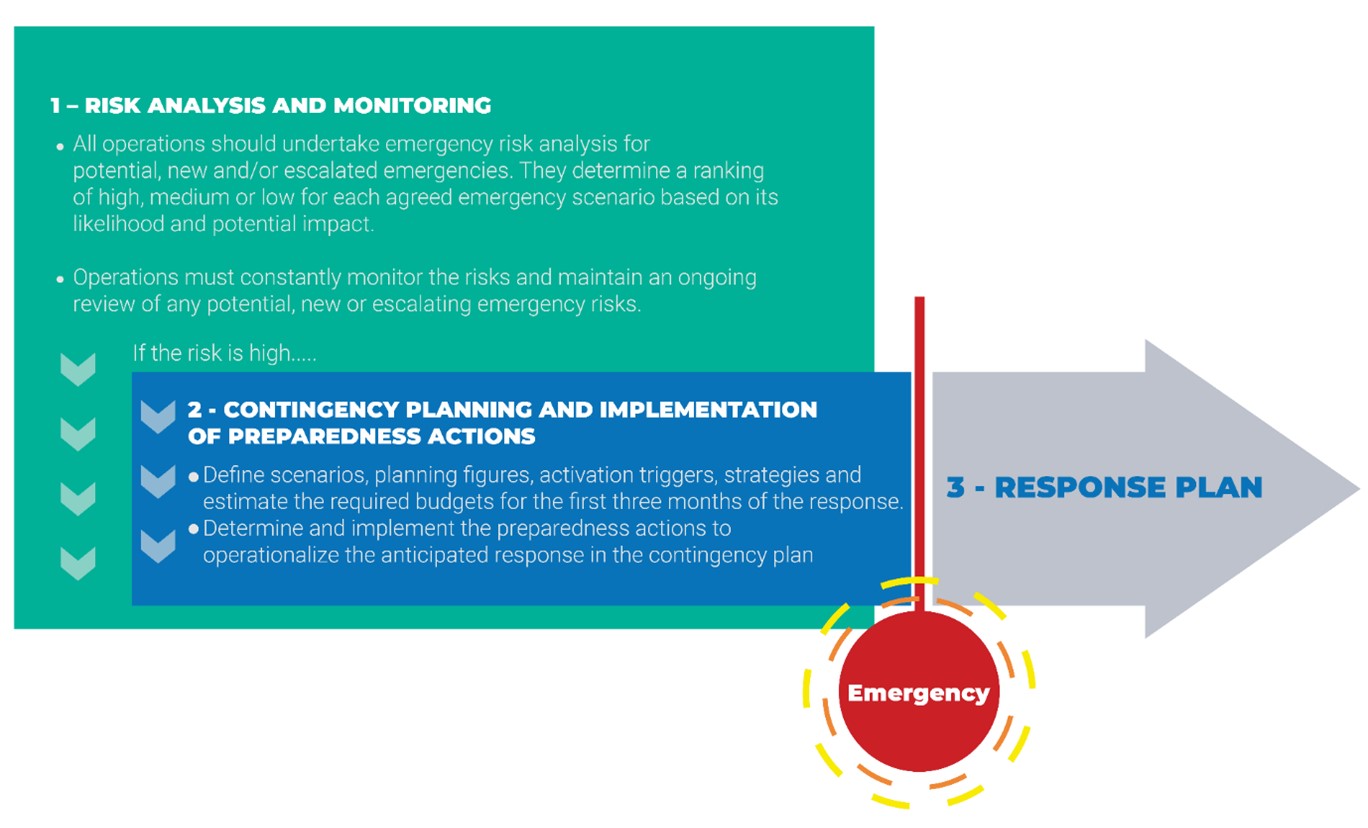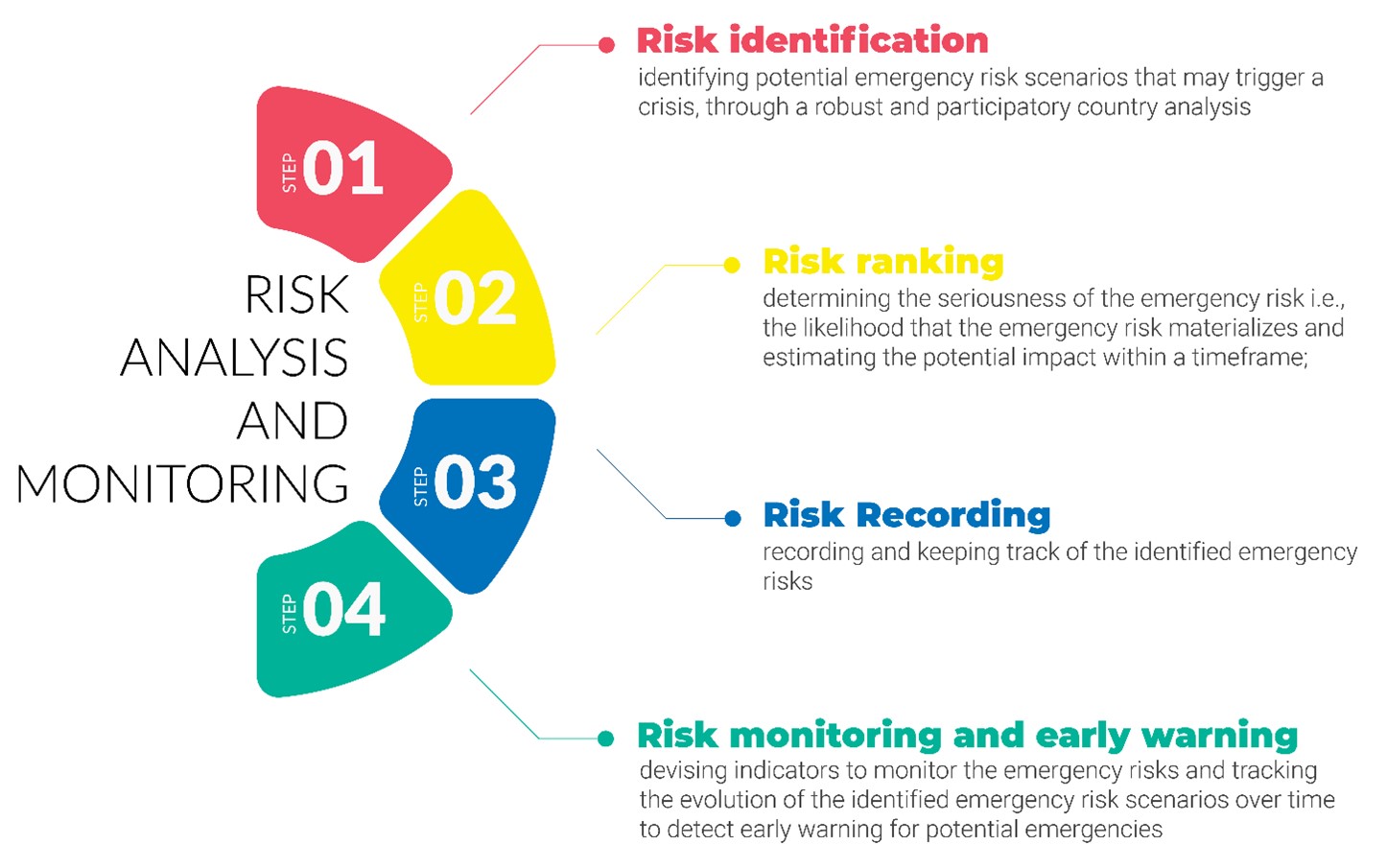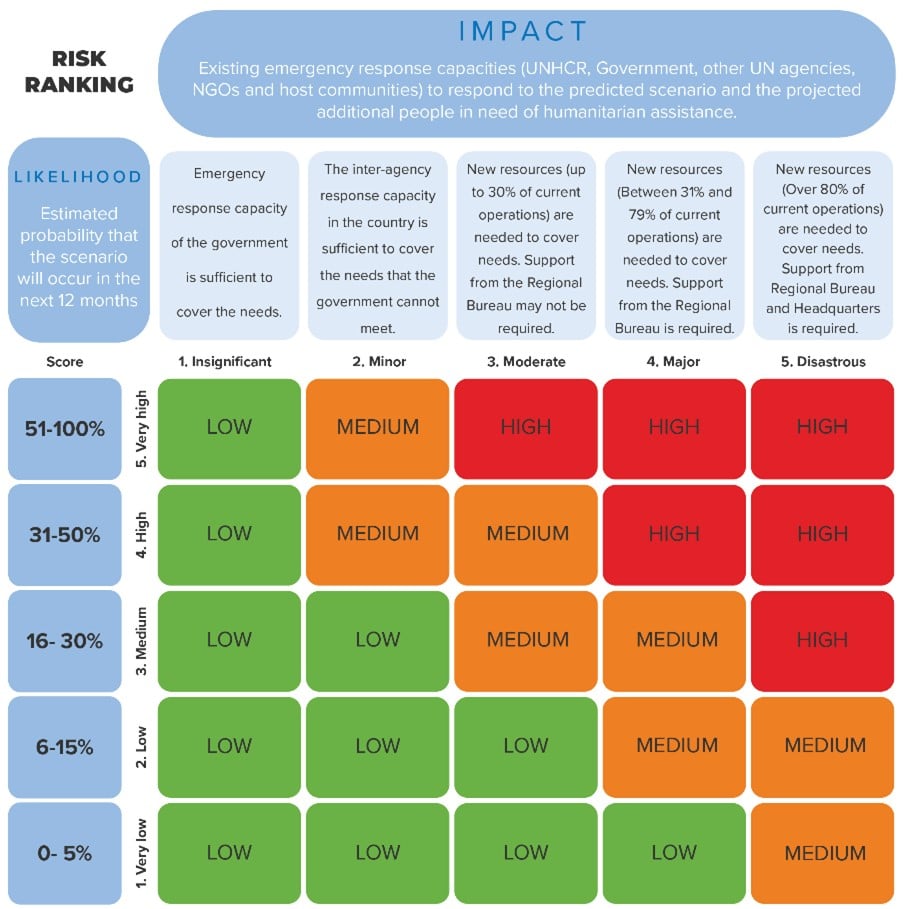Overview
This entry focuses on guiding operations to prepare for all anticipated humanitarian emergencies in which UNHCR may engage, whether triggered by armed conflict, violence and human rights violations, and/or natural hazards, climate change and other environmental events and conditions. It describes key emergency preparedness activities:
1. Emergency risk analysis and monitoring (UNHCR internal link) for new and/or escalated emergencies
2. Contingency planning (UNHCR internal link) and implementation of preparedness actions – especially for operations that face high risk(s) of a new or escalated emergency
Building Blocks of Emergency Preparedness

Relevance for emergency operations
Emergency preparedness refers to actions and measures introduced before the onset of an emergency to improve the effectiveness, efficiency, timeliness and accountability of emergency responses to save lives and provide protection. When humanitarian actors invest in preparedness measures for an imminent or anticipated humanitarian crisis, they help mitigate suffering by ensuring timely responses to address the urgent - often life-saving - and immediate needs in the most effective and efficient manner possible.
UNHCR’s Guidance on Emergency Preparedness (UNHCR-OG-2023-02) provides a practical framework to support effective operationalisation and implementation of the UNHCR Policy on Emergency Preparedness and Response (UNHCR/HCP/2023/01). While the Emergency Policy provides the overarching framework, the guidance is a tool that will assist UNHCR staff members and affiliate workforce in fulfilling their responsibilities under the Emergency Policy, as relates to preparedness measures.
This entry summarizes key points of the Guidance on Emergency Preparedness.
Main guidance
1. Emergency risk analysis and monitoring
The key to proactive preparedness is strong risk management. Emergency risk analysis is the comprehensive process of identifying, ranking, and recording emergency risks, followed by monitoring emergency risks - on which contingency planning is based. This should be conducted through a workshop and involve a multi-functional team. Senior management and all key international and national personnel involved in planning and decision-making should participate, and if the operation has multiple offices, the risk review should include personnel from all locations.
All country operations must undertake emergency risk analysis based on likelihood and impact for new or escalated emergencies. Given the sometimes unpredictable nature of emergency events and the essential need for emergency preparedness, operations must constantly monitor the risks and maintain an ongoing review of any potential, new or escalating emergency risks.
Follow the four Steps of Emergency Risk analysis and Monitoring

The risk ranking matrix provides the definition of likelihood and impact for emergency risks, as well as how to determine the risk level.
Risk ranking matrix for emergency risk

UNHCR maintains a global overview of emergency risks on the Emergency Preparedness and Response Portal (UNHCR internal link).
Useful Tools for Emergency Risk Analysis (UNHCR internal link)
- Kobo Risk Analysis Tool guides country operations through the process of hazard identification, scenario identification and risk ranking. It aims to help operations structure the risk analysis process and develop scenarios for contingency planning.
- Risk Management Tool for Emergencies provides examples of risk causes, events, proactive and reactive treatments for country operations when recording emergency risks in the Enterprise Risk Management’s operational risk register.
For more information on UNHCR’s roles in risk analysis in refugee, internal displacement, mixed situation and mixed movements, see Guidance on Emergency Preparedness and Response.
2. Contingency planning and implementation of preparedness actions
Contingency planning will ensure a timely and effective response when an emergency occurs. In line with the Emergency Policy, country operations that face high risk(s) of a new or escalated emergency should develop a scenario-based contingency plan(s) in collaboration with government
counterparts and other partners. The development of a contingency plan is strongly recommended when the risk level is determined to be medium.
This is applicable in all situations (refugee, IDP, mixed situations and mixed movements). For more information on UNHCR’s roles in contingency planning in refugee, internal displacement, mixed situation and mixed movements, see Guidance on Emergency Preparedness and Response.
A scenario-based contingency plan states the actions that need to be taken, by whom, where, and with what immediately available resources during the initial emergency response (first three months), should a specific risk scenario occur and once pre-identified activating triggers are met. The contingency plan should reflect UNHCR’s operational and coordination responsibilities and objectives and result in the following:
- A clear, practical, scenario-based response strategy reflecting agreement between UNHCR, the government and other partners;
- An overview of resources required to respond to the high-risk scenario for the first three months of the response, and who/ how these resources will be provided;
- An understanding of when and how to activate the contingency plan (based on the agreed triggers and risk monitoring);
- Increased preparedness levels through the implementation of preparedness actions;
- A timely response towards the protection of forcibly displaced and stateless persons.
As part of contingency planning, country operations need to identify key preparedness actions that will be implemented to enable the planned emergency response. The List of Preparedness Actions provided in the Guidance is organised by functional area reflecting UNHCR's mandated role in refugee situations, and UNHCR’s cluster leadership accountability in internal displacement situations, alongside its operational engagement in IDP situations.
Useful Tools for contingency planning (UNHCR internal link)
Policies and guidelines
Annexes
Main contacts
Emergency Preparedness Unit in the Division of Emergency and Programme Support (DEPS)
In this section:
Let us know what you think of the new site and help us improve your user experience….
Let us know what you think of the new site and help us improve your user experience….
